power steering JEEP PATRIOT 2019 Owner handbook (in English)
[x] Cancel search | Manufacturer: JEEP, Model Year: 2019, Model line: PATRIOT, Model: JEEP PATRIOT 2019Pages: 332, PDF Size: 1.99 MB
Page 17 of 332
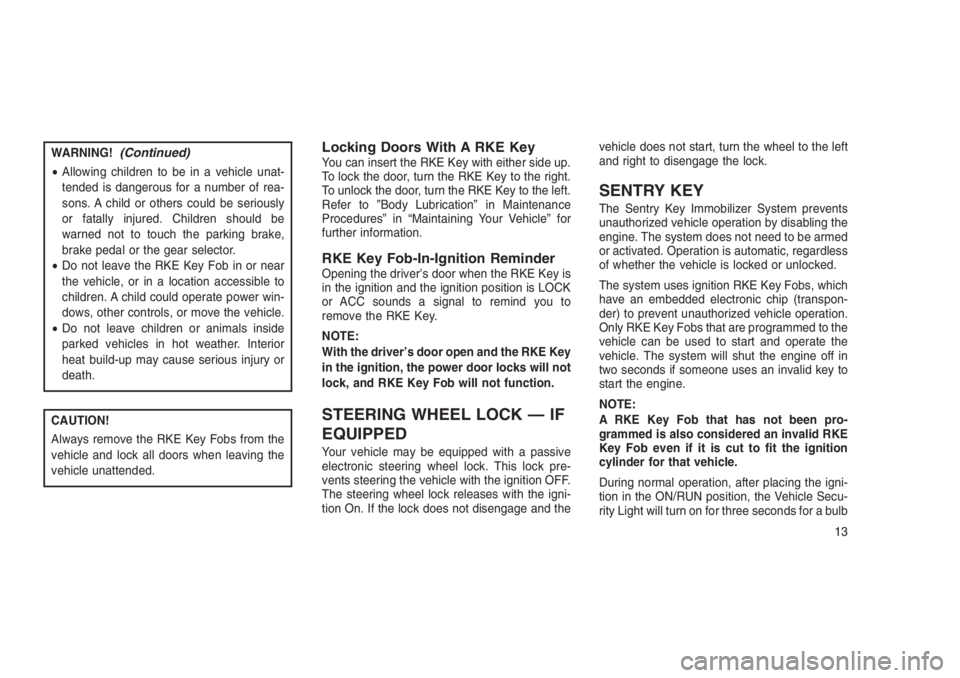
WARNING!(Continued)
•Allowing children to be in a vehicle unat-
tended is dangerous for a number of rea-
sons. A child or others could be seriously
or fatally injured. Children should be
warned not to touch the parking brake,
brake pedal or the gear selector.
•Do not leave the RKE Key Fob in or near
the vehicle, or in a location accessible to
children. A child could operate power win-
dows, other controls, or move the vehicle.
•Do not leave children or animals inside
parked vehicles in hot weather. Interior
heat build-up may cause serious injury or
death.
CAUTION!
Always remove the RKE Key Fobs from the
vehicle and lock all doors when leaving the
vehicle unattended.
Locking Doors With A RKE KeyYou can insert the RKE Key with either side up.
To lock the door, turn the RKE Key to the right.
To unlock the door, turn the RKE Key to the left.
Refer to ”Body Lubrication” in Maintenance
Procedures” in “Maintaining Your Vehicle” for
further information.
RKE Key Fob-In-Ignition ReminderOpening the driver’s door when the RKE Key is
in the ignition and the ignition position is LOCK
or ACC sounds a signal to remind you to
remove the RKE Key.
NOTE:
With the driver’s door open and the RKE Key
in the ignition, the power door locks will not
lock, and RKE Key Fob will not function.
STEERING WHEEL LOCK — IF
EQUIPPED
Your vehicle may be equipped with a passive
electronic steering wheel lock. This lock pre-
vents steering the vehicle with the ignition OFF.
The steering wheel lock releases with the igni-
tion On. If the lock does not disengage and thevehicle does not start, turn the wheel to the left
and right to disengage the lock.
SENTRY KEY
The Sentry Key Immobilizer System prevents
unauthorized vehicle operation by disabling the
engine. The system does not need to be armed
or activated. Operation is automatic, regardless
of whether the vehicle is locked or unlocked.
The system uses ignition RKE Key Fobs, which
have an embedded electronic chip (transpon-
der) to prevent unauthorized vehicle operation.
Only RKE Key Fobs that are programmed to the
vehicle can be used to start and operate the
vehicle. The system will shut the engine off in
two seconds if someone uses an invalid key to
start the engine.
NOTE:
A RKE Key Fob that has not been pro-
grammed is also considered an invalid RKE
Key Fob even if it is cut to fit the ignition
cylinder for that vehicle.
During normal operation, after placing the igni-
tion in the ON/RUN position, the Vehicle Secu-
rity Light will turn on for three seconds for a bulb
13
Page 64 of 332
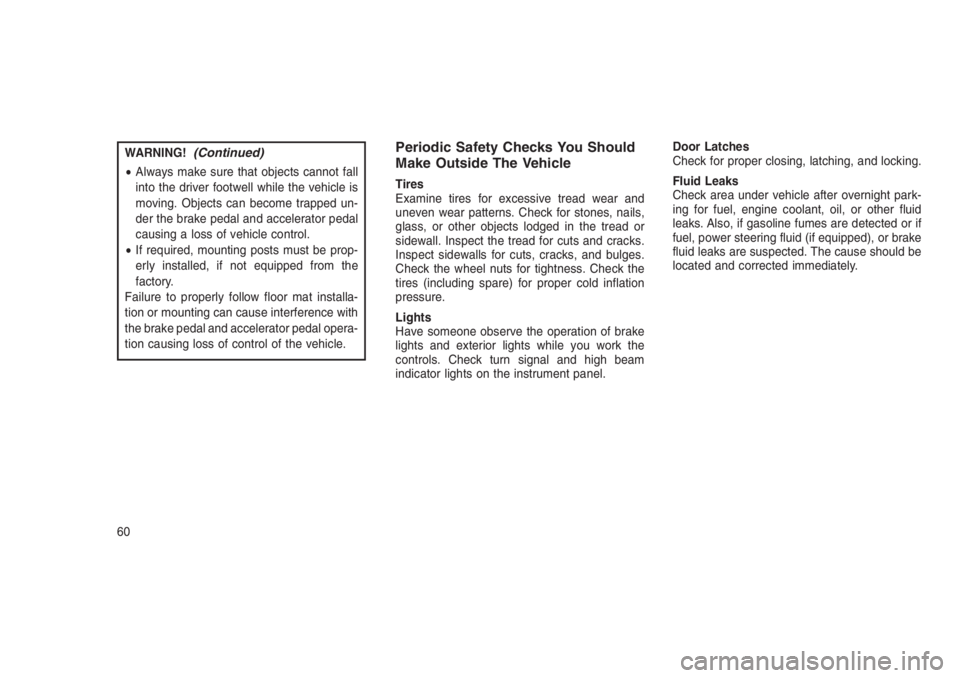
WARNING!(Continued)
•Always make sure that objects cannot fall
into the driver footwell while the vehicle is
moving. Objects can become trapped un-
der the brake pedal and accelerator pedal
causing a loss of vehicle control.
•If required, mounting posts must be prop-
erly installed, if not equipped from the
factory.
Failure to properly follow floor mat installa-
tion or mounting can cause interference with
the brake pedal and accelerator pedal opera-
tion causing loss of control of the vehicle.
Periodic Safety Checks You Should
Make Outside The Vehicle
Tires
Examine tires for excessive tread wear and
uneven wear patterns. Check for stones, nails,
glass, or other objects lodged in the tread or
sidewall. Inspect the tread for cuts and cracks.
Inspect sidewalls for cuts, cracks, and bulges.
Check the wheel nuts for tightness. Check the
tires (including spare) for proper cold inflation
pressure.
Lights
Have someone observe the operation of brake
lights and exterior lights while you work the
controls. Check turn signal and high beam
indicator lights on the instrument panel.Door Latches
Check for proper closing, latching, and locking.
Fluid Leaks
Check area under vehicle after overnight park-
ing for fuel, engine coolant, oil, or other fluid
leaks. Also, if gasoline fumes are detected or if
fuel, power steering fluid (if equipped), or brake
fluid leaks are suspected. The cause should be
located and corrected immediately.
60
Page 67 of 332
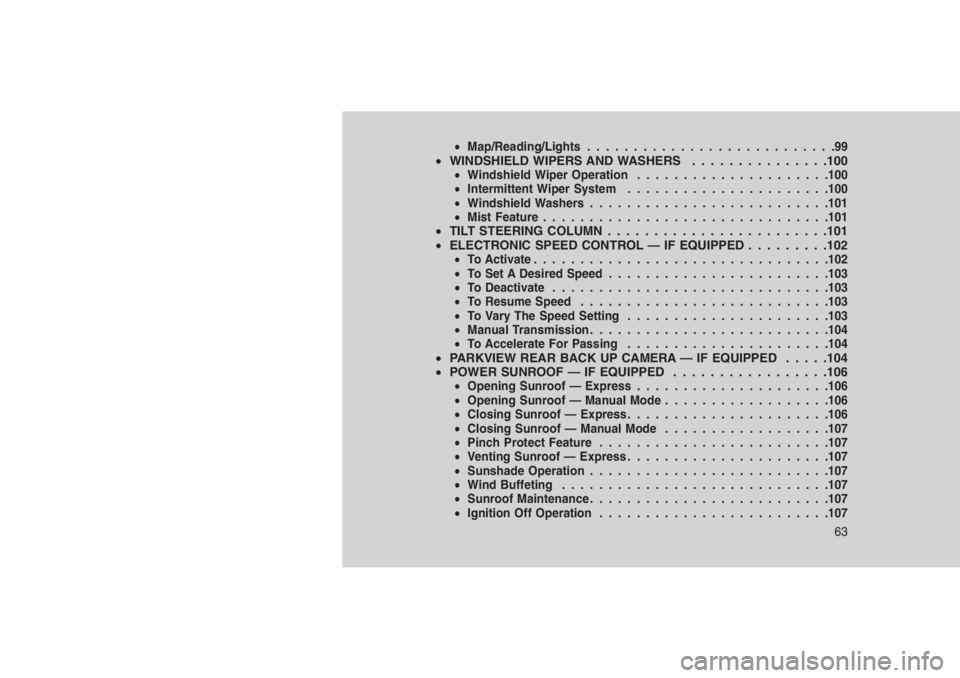
•Map/Reading/Lights...........................99•WINDSHIELD WIPERS AND WASHERS . . . . . . .. . . . . . . .100•Windshield Wiper Operation.....................100
•Intermittent Wiper System......................100
•Windshield Washers..........................101
•Mist Feature...............................101
•TILT STEERING COLUMN . . . . . . . . . . . . . . . . . . . . . . . .101
•ELECTRONIC SPEED CONTROL — IF EQUIPPED . . . . .. . . .102
•To Activate................................102
•To Set A Desired Speed........................103
•To Deactivate..............................103
•To Resume Speed...........................103
•To Vary The Speed Setting......................103
•Manual Transmission..........................104
•To Accelerate For Passing......................104
•PARKVIEW REAR BACK UP CAMERA — IF EQUIPPED . . . . .104
•POWER SUNROOF — IF EQUIPPED . . .. . . . . . . . . . . . . .106
•Opening Sunroof — Express.....................106
•Opening Sunroof — Manual Mode..................106
•Closing Sunroof — Express......................106
•Closing Sunroof — Manual Mode..................107
•Pinch Protect Feature.........................107
•Venting Sunroof — Express......................107
•Sunshade Operation..........................107
•Wind Buffeting.............................107
•Sunroof Maintenance..........................107
•Ignition Off Operation.........................107
63
Page 166 of 332
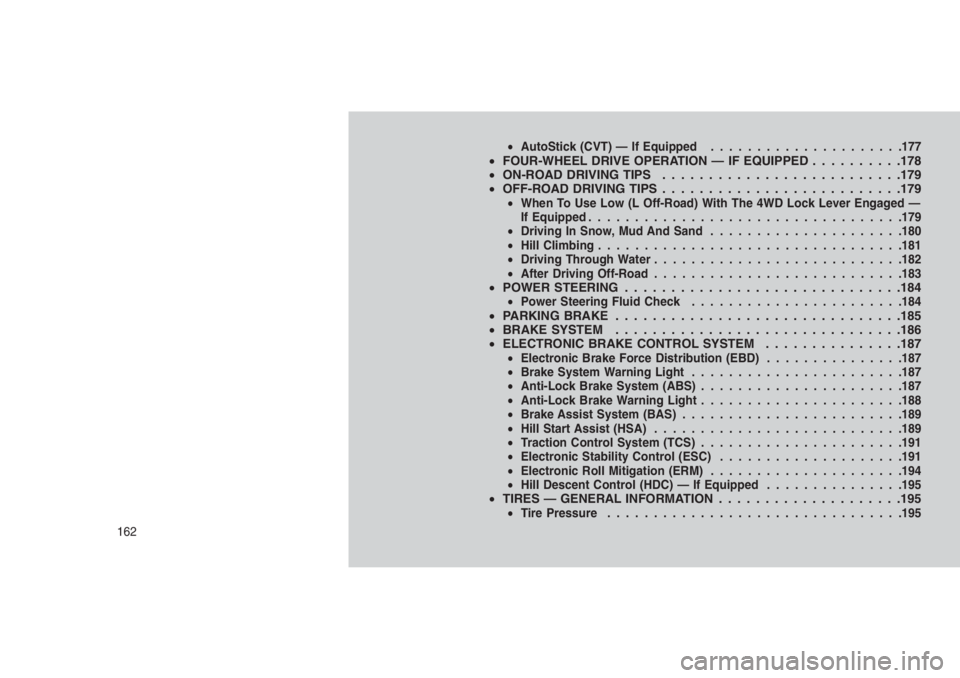
•AutoStick (CVT) — If Equipped.....................177•FOUR-WHEEL DRIVE OPERATION — IF EQUIPPED . . . . . . . . . .178
•ON-ROAD DRIVING TIPS . . . . . . . . . . . . . . . . . .........179
•OFF-ROAD DRIVING TIPS..........................179
•When To Use Low (L Off-Road) With The 4WD Lock Lever Engaged —
If Equipped..................................179
•Driving In Snow, Mud And Sand.....................180
•Hill Climbing.................................181
•Driving Through Water...........................182
•After Driving Off-Road...........................183
•POWER STEERING . . . . . . . . . .....................184•Power Steering Fluid Check.......................184•PARKING BRAKE . ..............................185
•BRAKE SYSTEM . . . . . . . . . . . . . . . . . ..............186
•ELECTRONIC BRAKE CONTROL SYSTEM . . . . . . . . . ......187
•Electronic Brake Force Distribution (EBD)...............187
•Brake System Warning Light.......................187
•Anti-Lock Brake System (ABS)......................187
•Anti-Lock Brake Warning Light......................188
•Brake Assist System (BAS)........................189
•Hill Start Assist (HSA)...........................189
•Traction Control System (TCS)......................191
•Electronic Stability Control (ESC)....................191
•Electronic Roll Mitigation (ERM).....................194
•Hill Descent Control (HDC) — If Equipped...............195
•TIRES — GENERAL INFORMATION . . . . . . . . . . . . . . . . . . . .195•Tire Pressure................................195
162
Page 183 of 332
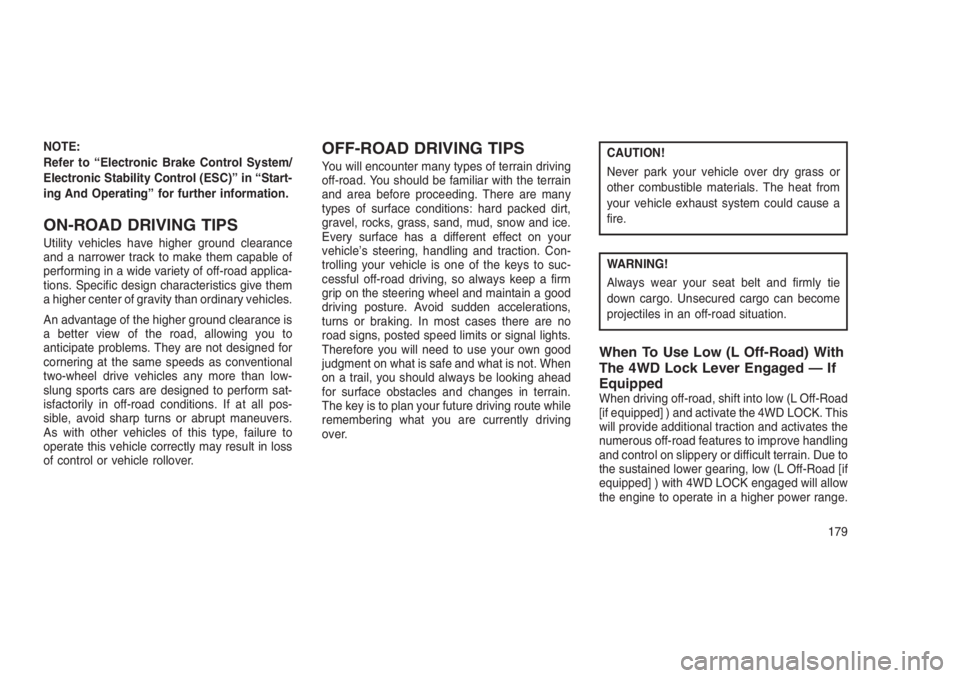
NOTE:
Refer to “Electronic Brake Control System/
Electronic Stability Control (ESC)” in “Start-
ing And Operating” for further information.
ON-ROAD DRIVING TIPS
Utility vehicles have higher ground clearance
and a narrower track to make them capable of
performing in a wide variety of off-road applica-
tions. Specific design characteristics give them
a higher center of gravity than ordinary vehicles.
An advantage of the higher ground clearance is
a better view of the road, allowing you to
anticipate problems. They are not designed for
cornering at the same speeds as conventional
two-wheel drive vehicles any more than low-
slung sports cars are designed to perform sat-
isfactorily in off-road conditions. If at all pos-
sible, avoid sharp turns or abrupt maneuvers.
As with other vehicles of this type, failure to
operate this vehicle correctly may result in loss
of control or vehicle rollover.
OFF-ROAD DRIVING TIPS
You will encounter many types of terrain driving
off-road. You should be familiar with the terrain
and area before proceeding. There are many
types of surface conditions: hard packed dirt,
gravel, rocks, grass, sand, mud, snow and ice.
Every surface has a different effect on your
vehicle’s steering, handling and traction. Con-
trolling your vehicle is one of the keys to suc-
cessful off-road driving, so always keep a firm
grip on the steering wheel and maintain a good
driving posture. Avoid sudden accelerations,
turns or braking. In most cases there are no
road signs, posted speed limits or signal lights.
Therefore you will need to use your own good
judgment on what is safe and what is not. When
on a trail, you should always be looking ahead
for surface obstacles and changes in terrain.
The key is to plan your future driving route while
remembering what you are currently driving
over.CAUTION!
Never park your vehicle over dry grass or
other combustible materials. The heat from
your vehicle exhaust system could cause a
fire.
WARNING!
Always wear your seat belt and firmly tie
down cargo. Unsecured cargo can become
projectiles in an off-road situation.
When To Use Low (L Off-Road) With
The 4WD Lock Lever Engaged — If
Equipped
When driving off-road, shift into low (L Off-Road
[if equipped] ) and activate the 4WD LOCK. This
will provide additional traction and activates the
numerous off-road features to improve handling
and control on slippery or difficult terrain. Due to
the sustained lower gearing, low (L Off-Road [if
equipped] ) with 4WD LOCK engaged will allow
the engine to operate in a higher power range.
179
Page 185 of 332
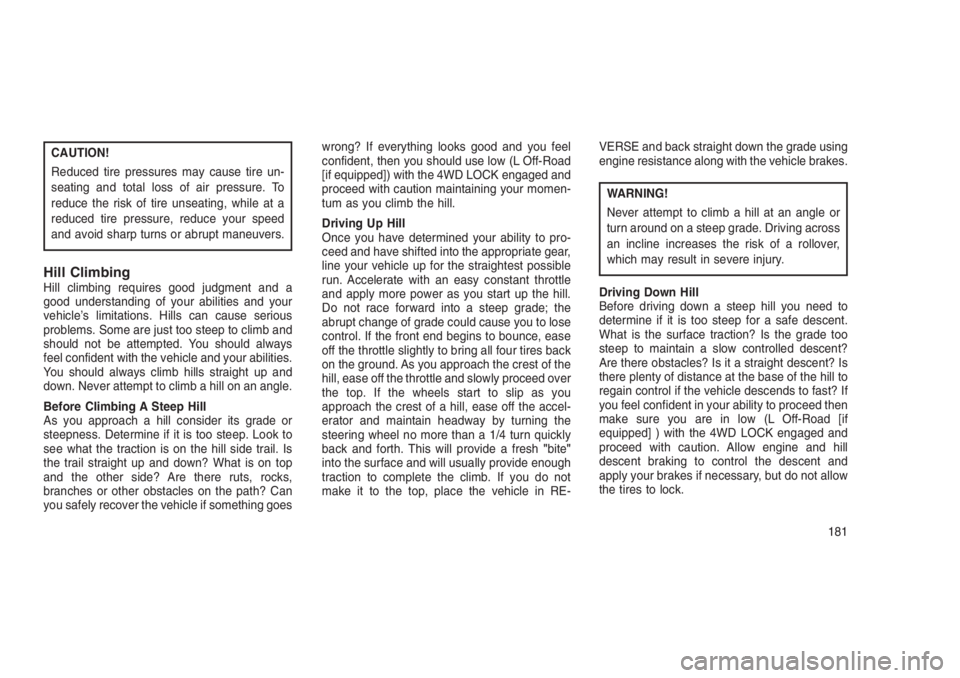
CAUTION!
Reduced tire pressures may cause tire un-
seating and total loss of air pressure. To
reduce the risk of tire unseating, while at a
reduced tire pressure, reduce your speed
and avoid sharp turns or abrupt maneuvers.
Hill ClimbingHill climbing requires good judgment and a
good understanding of your abilities and your
vehicle’s limitations. Hills can cause serious
problems. Some are just too steep to climb and
should not be attempted. You should always
feel confident with the vehicle and your abilities.
You should always climb hills straight up and
down. Never attempt to climb a hill on an angle.
Before Climbing A Steep Hill
As you approach a hill consider its grade or
steepness. Determine if it is too steep. Look to
see what the traction is on the hill side trail. Is
the trail straight up and down? What is on top
and the other side? Are there ruts, rocks,
branches or other obstacles on the path? Can
you safely recover the vehicle if something goeswrong? If everything looks good and you feel
confident, then you should use low (L Off-Road
[if equipped]) with the 4WD LOCK engaged and
proceed with caution maintaining your momen-
tum as you climb the hill.
Driving Up Hill
Once you have determined your ability to pro-
ceed and have shifted into the appropriate gear,
line your vehicle up for the straightest possible
run. Accelerate with an easy constant throttle
and apply more power as you start up the hill.
Do not race forward into a steep grade; the
abrupt change of grade could cause you to lose
control. If the front end begins to bounce, ease
off the throttle slightly to bring all four tires back
on the ground. As you approach the crest of the
hill, ease off the throttle and slowly proceed over
the top. If the wheels start to slip as you
approach the crest of a hill, ease off the accel-
erator and maintain headway by turning the
steering wheel no more than a 1/4 turn quickly
back and forth. This will provide a fresh"bite"
into the surface and will usually provide enough
traction to complete the climb. If you do not
make it to the top, place the vehicle in RE-VERSE and back straight down the grade using
engine resistance along with the vehicle brakes.
WARNING!
Never attempt to climb a hill at an angle or
turn around on a steep grade. Driving across
an incline increases the risk of a rollover,
which may result in severe injury.
Driving Down Hill
Before driving down a steep hill you need to
determine if it is too steep for a safe descent.
What is the surface traction? Is the grade too
steep to maintain a slow controlled descent?
Are there obstacles? Is it a straight descent? Is
there plenty of distance at the base of the hill to
regain control if the vehicle descends to fast? If
you feel confident in your ability to proceed then
make sure you are in low (L Off-Road [if
equipped] ) with the 4WD LOCK engaged and
proceed with caution. Allow engine and hill
descent braking to control the descent and
apply your brakes if necessary, but do not allow
the tires to lock.
181
Page 188 of 332
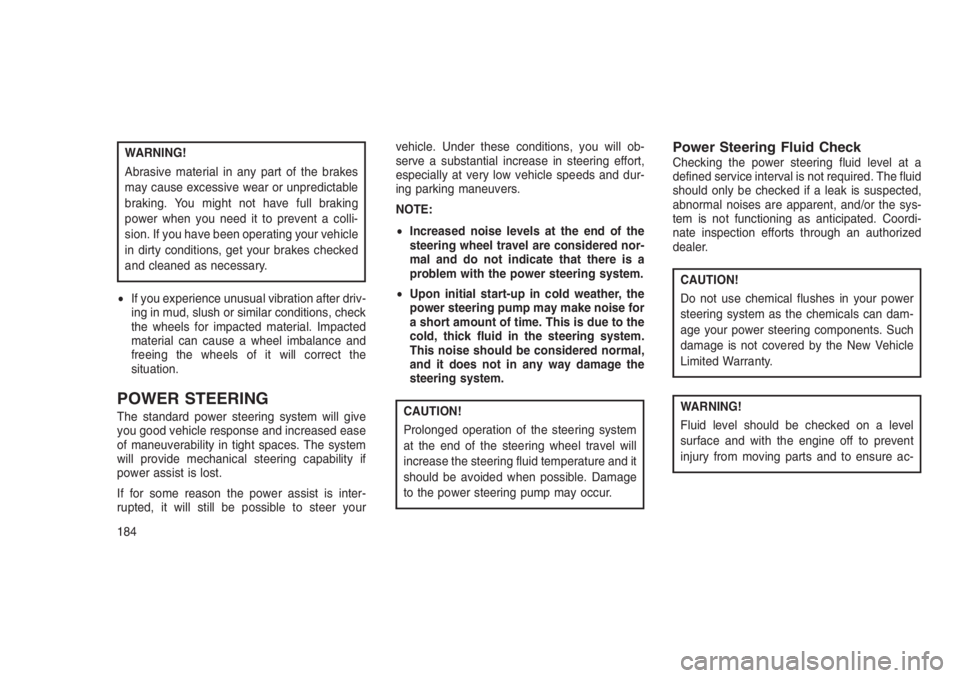
WARNING!
Abrasive material in any part of the brakes
may cause excessive wear or unpredictable
braking. You might not have full braking
power when you need it to prevent a colli-
sion. If you have been operating your vehicle
in dirty conditions, get your brakes checked
and cleaned as necessary.
•If you experience unusual vibration after driv-
ing in mud, slush or similar conditions, check
the wheels for impacted material. Impacted
material can cause a wheel imbalance and
freeing the wheels of it will correct the
situation.
POWER STEERING
The standard power steering system will give
you good vehicle response and increased ease
of maneuverability in tight spaces. The system
will provide mechanical steering capability if
power assist is lost.
If for some reason the power assist is inter-
rupted, it will still be possible to steer yourvehicle. Under these conditions, you will ob-
serve a substantial increase in steering effort,
especially at very low vehicle speeds and dur-
ing parking maneuvers.
NOTE:
•Increased noise levels at the end of the
steering wheel travel are considered nor-
mal and do not indicate that there is a
problem with the power steering system.
•Upon initial start-up in cold weather, the
power steering pump may make noise for
a short amount of time. This is due to the
cold, thick fluid in the steering system.
This noise should be considered normal,
and it does not in any way damage the
steering system.CAUTION!
Prolonged operation of the steering system
at the end of the steering wheel travel will
increase the steering fluid temperature and it
should be avoided when possible. Damage
to the power steering pump may occur.
Power Steering Fluid CheckChecking the power steering fluid level at a
defined service interval is not required. The fluid
should only be checked if a leak is suspected,
abnormal noises are apparent, and/or the sys-
tem is not functioning as anticipated. Coordi-
nate inspection efforts through an authorized
dealer.
CAUTION!
Do not use chemical flushes in your power
steering system as the chemicals can dam-
age your power steering components. Such
damage is not covered by the New Vehicle
Limited Warranty.
WARNING!
Fluid level should be checked on a level
surface and with the engine off to prevent
injury from moving parts and to ensure ac-
184
Page 189 of 332
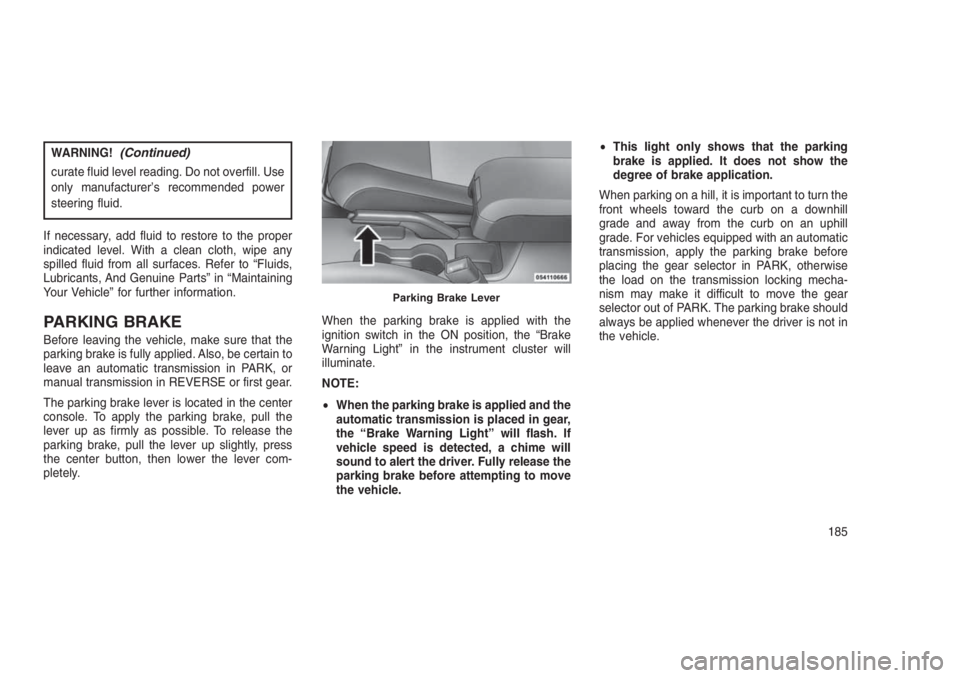
WARNING!(Continued)
curate fluid level reading. Do not overfill. Use
only manufacturer’s recommended power
steering fluid.
If necessary, add fluid to restore to the proper
indicated level. With a clean cloth, wipe any
spilled fluid from all surfaces. Refer to “Fluids,
Lubricants, And Genuine Parts” in “Maintaining
Your Vehicle” for further information.
PARKING BRAKE
Before leaving the vehicle, make sure that the
parking brake is fully applied. Also, be certain to
leave an automatic transmission in PARK, or
manual transmission in REVERSE or first gear.
The parking brake lever is located in the center
console. To apply the parking brake, pull the
lever up as firmly as possible. To release the
parking brake, pull the lever up slightly, press
the center button, then lower the lever com-
pletely.When the parking brake is applied with the
ignition switch in the ON position, the “Brake
Warning Light” in the instrument cluster will
illuminate.
NOTE:
•When the parking brake is applied and the
automatic transmission is placed in gear,
the “Brake Warning Light” will flash. If
vehicle speed is detected, a chime will
sound to alert the driver. Fully release the
parking brake before attempting to move
the vehicle.•This light only shows that the parking
brake is applied. It does not show the
degree of brake application.
When parking on a hill, it is important to turn the
front wheels toward the curb on a downhill
grade and away from the curb on an uphill
grade. For vehicles equipped with an automatic
transmission, apply the parking brake before
placing the gear selector in PARK, otherwise
the load on the transmission locking mecha-
nism may make it difficult to move the gear
selector out of PARK. The parking brake should
always be applied whenever the driver is not in
the vehicle.
Parking Brake Lever
185
Page 195 of 332

four times within twenty seconds. The “ESC
Off Indicator Light” should turn on and turn
off two times.
7. Rotate the steering wheel back to center and
then an additional slighty more than one-half
turn to the right.
8. Turn the ignition switch to the OFF position
and then back to the ON position. If the
sequence was completed properly, the “ESC
Off Indicator Light” will blink several times to
confirm HSA is disabled.
9. Repeat these steps if you want to return this
feature to its previous setting.
Traction Control System (TCS)This system monitors the amount of wheel spin
of each of the driven wheels. If wheel spin is
detected, the TCS may apply brake pressure to
the spinning wheel(s) and/or reduce engine
power to provide enhanced acceleration and
stability. A feature of the TCS, Brake Limited
Differential (BLD), functions similar to a limited
slip differential and controls the wheel spin
across a driven axle. If one wheel on a drivenaxle is spinning faster than the other, the sys-
tem will apply the brake of the spinning wheel.
This will allow more engine torque to be applied
to the wheel that is not spinning. BLD may
remain enabled even if TCS and ESC are in a
reduced mode.
Electronic Stability Control (ESC)This system enhances directional control and
stability of the vehicle under various driving
conditions. ESC corrects for over-steering or
under-steering of the vehicle by applying the
brake of the appropriate wheel to assist in
counteracting the over-steering or under-
steering condition. Engine power may also be
reduced to help the vehicle maintain the desired
path. ESC uses sensors in the vehicle to deter-
mine the vehicle path intended by the driver and
compares it to the actual path of the vehicle.
When the actual path does not match the
intended path, ESC applies the brake of the
appropriate wheel to assist in counteracting the
over-steer or under-steer condition
•Oversteer - when the vehicle is turning more
than appropriate for the steering wheel posi-
tion.•Understeer - when the vehicle is turning less
than appropriate for the steering wheel
position.
WARNING!
•The Electronic Stability Control (ESC) can-
not prevent the natural laws of physics
from acting on the vehicle, nor can it
increase the traction afforded by prevailing
road conditions.
•ESC cannot prevent accidents, including
those resulting from excessive speed in
turns, driving on very slippery surfaces, or
hydroplaning. ESC also cannot prevent
collisions resulting from loss of vehicle
control due to inappropriate driver input for
the conditions. Only a safe, attentive, and
skillful driver can prevent collisions.
(Continued)
191
Page 198 of 332
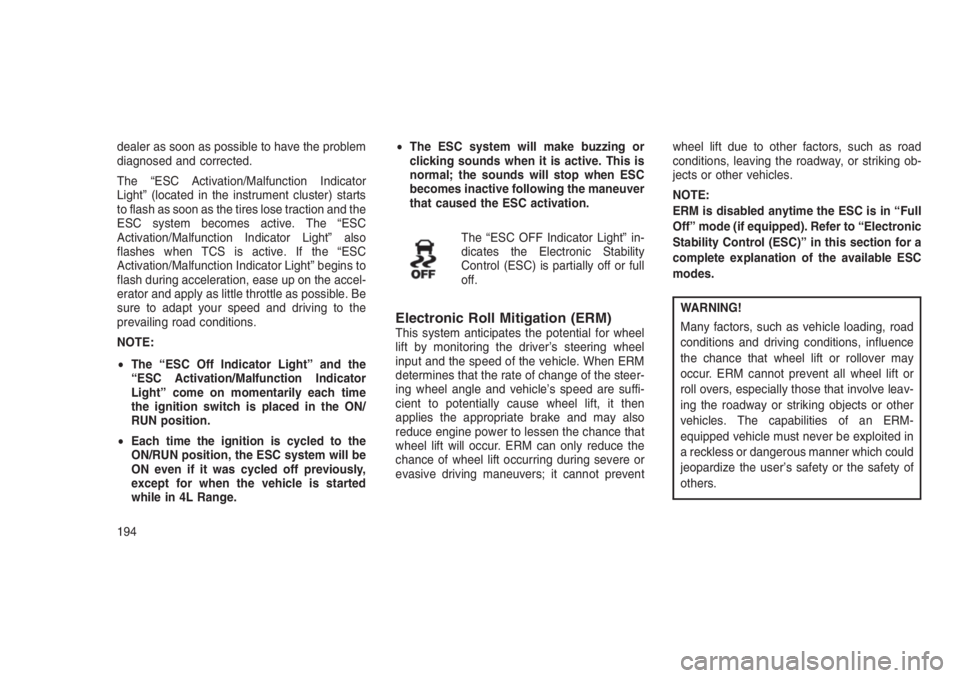
dealer as soon as possible to have the problem
diagnosed and corrected.
The “ESC Activation/Malfunction Indicator
Light” (located in the instrument cluster) starts
to flash as soon as the tires lose traction and the
ESC system becomes active. The “ESC
Activation/Malfunction Indicator Light” also
flashes when TCS is active. If the “ESC
Activation/Malfunction Indicator Light” begins to
flash during acceleration, ease up on the accel-
erator and apply as little throttle as possible. Be
sure to adapt your speed and driving to the
prevailing road conditions.
NOTE:
•The “ESC Off Indicator Light” and the
“ESC Activation/Malfunction Indicator
Light” come on momentarily each time
the ignition switch is placed in the ON/
RUN position.
•Each time the ignition is cycled to the
ON/RUN position, the ESC system will be
ON even if it was cycled off previously,
except for when the vehicle is started
while in 4L Range.•The ESC system will make buzzing or
clicking sounds when it is active. This is
normal; the sounds will stop when ESC
becomes inactive following the maneuver
that caused the ESC activation.
The “ESC OFF Indicator Light” in-
dicates the Electronic Stability
Control (ESC) is partially off or full
off.
Electronic Roll Mitigation (ERM)This system anticipates the potential for wheel
lift by monitoring the driver’s steering wheel
input and the speed of the vehicle. When ERM
determines that the rate of change of the steer-
ing wheel angle and vehicle’s speed are suffi-
cient to potentially cause wheel lift, it then
applies the appropriate brake and may also
reduce engine power to lessen the chance that
wheel lift will occur. ERM can only reduce the
chance of wheel lift occurring during severe or
evasive driving maneuvers; it cannot preventwheel lift due to other factors, such as road
conditions, leaving the roadway, or striking ob-
jects or other vehicles.
NOTE:
ERM is disabled anytime the ESC is in “Full
Off” mode (if equipped). Refer to “Electronic
Stability Control (ESC)” in this section for a
complete explanation of the available ESC
modes.
WARNING!
Many factors, such as vehicle loading, road
conditions and driving conditions, influence
the chance that wheel lift or rollover may
occur. ERM cannot prevent all wheel lift or
roll overs, especially those that involve leav-
ing the roadway or striking objects or other
vehicles. The capabilities of an ERM-
equipped vehicle must never be exploited in
a reckless or dangerous manner which could
jeopardize the user’s safety or the safety of
others.
194